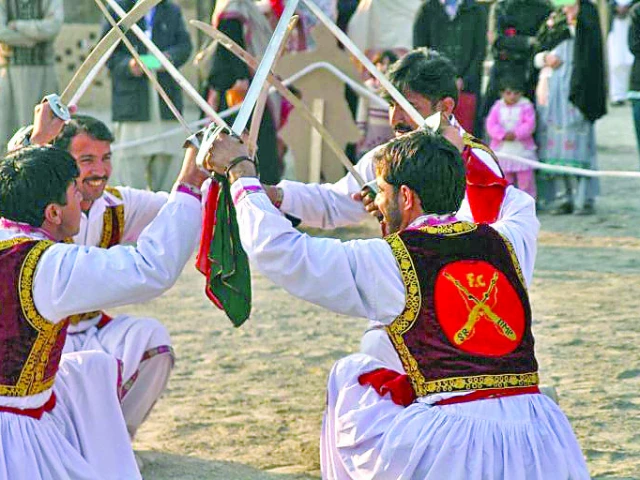Conventional cultural dance stays alive in Ok-P regardless of challenges. Picture: APP
PESHAWAR:
In a province as soon as shaken by years of terrorism, the rhythmic conflict of swords and the rising beat of drums proceed to echo with satisfaction, spreading heat throughout Khyber-Pakhtunkhwa (Ok-P).
Within the rugged plains and hills of the area, the centuries-old Khattak dance, Pakistan’s nationwide folks dance, stays defiantly alive regardless of repeated makes an attempt to silence cultural expression.
Celebrated worldwide as a land of artists and musicians, Ok-P has preserved this iconic custom even below the lengthy shadow of extremism. The dance continues to enthral spectators at weddings, births, sporting occasions and ceremonies welcoming dignitaries.
Launched by the Khattak tribe within the 14th century, it nonetheless holds satisfaction of place in cultural festivities, its fiery essence surviving greater than six centuries. “Khattak dance is as outdated because the historical past of the Khattak tribe itself,” mentioned Bakhtzada Khan, Assistant Director on the Ok-P Archaeology and Museums Division.
Passing by way of generations, the dance has impressed varieties resembling Braghoni, Shahdola, Balballah and Chitrali, all woven deeply into the area’s social material.
Historically carried out as a sword-wielding warm-up earlier than battle, the agile actions ready warriors for fight and celebrated victory. The Mughals and later the British admired the tribe’s bravery, and even the poet-warrior Khushal Khan Khattak is remembered for his hyperlink to its martial and creative spirit.
At the moment, dancers seem in brightly colored shalwars, frock-style kameezes and embroidered waistcoats, swirling in synchrony to the beat of drums and the piercing cry of the surnai.
For performers like Umar Bacha of Nowshera, the dance calls for peak bodily health. “One wants 100% health to carry out the Khattak dance,” he mentioned. Bacha performs with one, two and even three swords, executing speedy spins and complicated steps.
The routine options 5 major levels, from the opening Bhangarah to Derabi, Laila and the high-speed Braghoni, the place three swords are used – two swung within the air and one held within the mouth. The ultimate step, Bulbullah, is carried out with out weapons, as dancers sing romantic verses earlier than the tempo surges into an emotional climax.
Regardless of its cultural significance, the dance — like a lot of Ok-P’s creative heritage — suffered throughout years of terrorism. PML-N Nowshera President Hamza Khan lamented the decline, noting that seven of Peshawar’s oldest cinemas have been shut and little was achieved to revive music, movie or dance. But Ok-P has produced display screen legends together with Dilip Kumar, Raj Kapoor, Qavi Khan and Firdous Jamal.
Makes an attempt at revival gained momentum when the previous federal authorities introduced incentives for filmmakers, insurance coverage insurance policies for artists and plans for a Nationwide Movie Studio price Rs1 billion. Actor Javed Babar believes these measures will assist restore KP’s cultural panorama.
The dance’s attract has lengthy crossed borders; throughout her 1961 go to to the Khyber district, Queen Elizabeth II was reportedly captivated by its hypnotic rhythm. Cultural consultants now say preserving such traditions is important not just for celebration but additionally for countering extremism. “Selling cultural programmes and conventional dances helps counter intolerance,” mentioned Bakhtzada Khan. “It modifications mindsets and offers wholesome leisure.”
He added that reviving the hujra tradition may as soon as once more strengthen creative expression and fight divisive narratives. Regardless of years of violence and upheaval, the Khattak dance endures – its swords nonetheless flashing, its ft hanging the earth with satisfaction. In each spin and beat, Ok-P’s resilience lives on.

